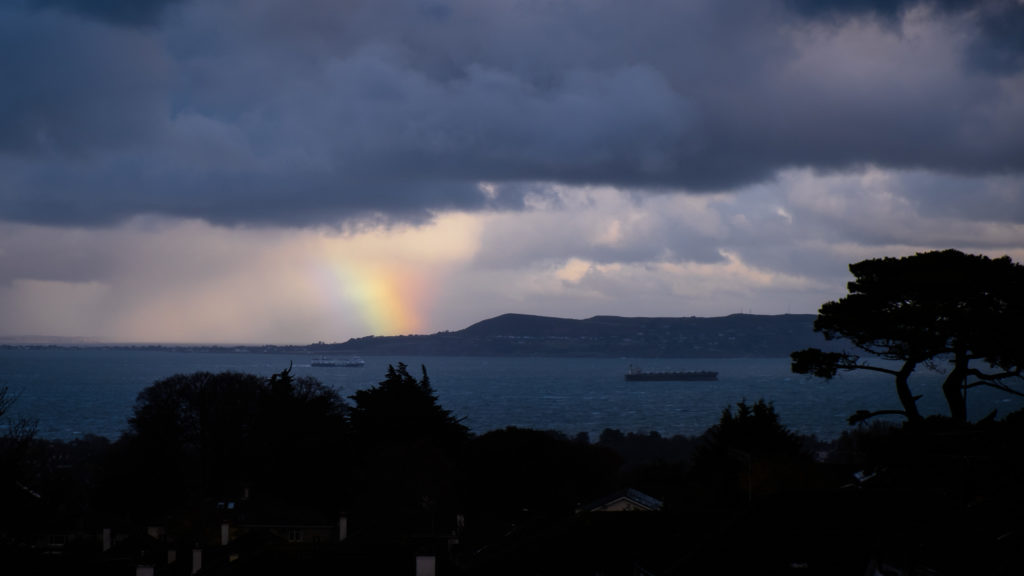Brown and green are shades rather than hues. You know this because you don’t see them in rainbows. Look, here’s a selection of some of my rainbows to remind you.

Rainbow in Sutton 2018 
Rainbow in Iceland 2017 
Bright Rainbow 2015
We carried brown scapulars around our necks as kids. We were encouraged to wear these devotional pouches, alleged to contain relics of the dead, as a mark of piety and faith. They were actually badges of membership of the tribe of Catholics. Family pilgrims would bring them as gifts from places of apparition and miracle healing. As bizarre as this seems to my rational adult brain, it holds several dubious lessons for me. Grooming for religious conversion isn’t a crime. Halidom fetishes are acceptable. And I can still go tribal at rugby matches.
The wearing of scapulars re-appeared during my university years. Quite a few people chose to keep Afghan Black or other diverting resins close to their hearts. The fashion of martyrdom for faith had been supplanted by nationalist causes and the resin mediated mental perceptions of religious experience.
They say that Francis I of France carried a pouch of mummy and rhubarb to ward off epilepsy.
In case you’re confused, Mummy is also known as the colour Egyptian Brown. Mummy ran out when the supply of mummies that could be pulverised had dried up. Mummy was doubtless corrupted with desiccated muscles, flesh, bones and bandages then spread on canvas for a new life. This was probably not a form of resurrection expected at the time of embalming.
Still confused? It gets worse. Caput Mortem might be a great title for a book of mysteries; the colour of dead man’s head that is also known as ‘cardinal purple’. Funny how alchemy named the brown rust of iron as ‘caput mortem’ yet it got hijacked as a shade of purple. Except that between times, it was also another name for Egyptian Brown.
Colour is confusing so its naming is also very confusing. And maleable. For example, Faber-Castell publish a table that includes their renaming of True Green, now known as Light Phthalo Green. They say such renaming creates names that are more familiar to the artists. And this is simply the English language story within a framework we know well.
The Namibian Himba tribe have five colour categories whereas Western cultures have eleven. Is this because the Himba see colour differently to us? Or is this about Himba concepts and thus language rather than wavelengths and different eyesight? And what do they call them? Have a read here for some possible explanations.
I’ve been rereading The Secret Lives of Colour by Kassia St Clair. Last year, I was lucky to have good reason to go to Cannes. That afforded me the excuse to walk up to the Musée Bonnard in Le Cannet. And that, as luck would have it, caused me to have the museum to myself at Sunday opening time. It’s not every day, nor likely any day, that you get to spend 40 minutes alone with 40 works by Bonnard, Picasso, Degas, Monet, Renoir, Sisley, Modigliani, Lautrec and others. The art dealer billionaire David Nahmad owns them all and more besides. There was a sign in the museum that said he didn’t believe art should be unseen by the public. Thank you M. Nahmad.
I’d also been twice to the Bonnard retrospective in the Tate Modern in London six months earlier. The point of all this was colour. And in particular, violet. And the impressionists period of ‘violettomania’. Some critics wondered if these artists could see further in the spectrum than other people. They didn’t all like the violets.
In 1881, Édouard Manet announced the colour of the atmosphere. ‘It is violet. Fresh air is violet. Three years from now, the whole world will work in violet’.
I could see the change, the influence of Monet’s statement was obvious in the selection I saw that Sunday in Le Cannet. The colours Bonnard was using for areas in shadow, trees for example, changed to violet. Violet became more prominent in each of the artists’ palettes through the 1880s and later.
I think this is a case where art followed industry. The British chemist Perkin had only created the colour mauveine in 1856 and Queen Victoria’s use of it in her clothing popularised it. Mauve was one of those expensive colours that had only been available to aristocracy and the super-rich. Mauveine became the first of the ‘new’ industrial dyes which changed fashion and art because artists could afford to use them.
I wonder if there could have been Impressionists if not for the chemist WH Perkin? He discovered alizarin red in 1871 though he was one of several to announce that same new dye in the same year. It’s a great stain that geologists and doctors and marine biologists have put to good use ever since. A case of science following industry, so to speak?

Leave a Reply